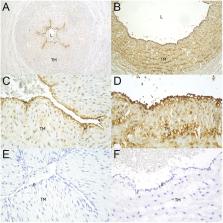'Pharmacological and immunohistochemical characterization of dopamine D4 receptor in human umbilical artery and vein' - a
#VascularBiology article by Bioscientifica Ltd on
#ScienceOpen:
https://www.scienceopen.com/document?vid=5e46957f-2653-4a18-826a-a89631ba9a60
Pharmacological and immunohistochemical characterization of dopamine D4 receptor in human umbilical artery and vein
<p xmlns:xsi="http://www.w3.org/2001/XMLSchema-instance" class="first" dir="auto" id="d16051631e285">To investigate the effects of the dopamine D4 receptor agonist A-412997 and the D
<sub>4</sub> antagonist sonepiprazole in human isolated umbilical artery (HUA) and vein (HUV)
and the expression of the D
<sub>4</sub> receptor by immunohistochemistry in these vessels. A segment of the umbilical cord
(10–20 cm) from the insertion point in the placenta and 5 cm from the umbilicus was
removed by the obstetrician and placed in a container with Krebs–Henseleit solution
(KHS). The Wharton’s jelly was removed, and HUA and HUV rings (3 mm) were suspended
in 10 mL organ baths containing oxygenated (95% O
<sub>2</sub>:5% CO
<sub>2</sub>) and heated (37 °C) KHS. For immunohistochemistry, the vessels were fixed in 10%
formalin, embedded in paraffin wax and sectioned (4 µm). A-412997 did not induce contractions
in the HUA rings. In HUA pre-contracted rings, A-412997 induced concentration-dependent
relaxations, which were reduced when the HUA rings were pre-incubated with L-NAME.
A-412997 caused concentration-dependent contractions of HUV rings, which were potentiated
by pre-treatment with L-NAME and reduced by pre-incubation with 6-nitrodopamine. In
HUV pre-contracted rings, A-412997 failed to induce relaxations. Sonepiprazole antagonized
A-412997-induced contractions in HUV rings and provoked concentration-dependent relaxations
in pre-contracted HUA and HUV rings. Dopamine D
<sub>4</sub> receptor was positive in both HUA and HUV, especially in the endothelium, and detected
only in HUV smooth muscle cells. Activation of HUA D4 receptor is associated with
relaxation, whereas in HUV, it leads to contraction. Differential expression of D4
receptors may modulate umbilical-placental blood flow.
</p>

Vascular Biology
<p>Fully open-access journal publishing the latest basic, clinical and translational research and reviews in the field of vascular biology, including cardiology, oncology, vascular development, inflammation, wound healing, and bioengineering. (published by Bioscientifica)</p>
Hi #ScienceMastodon, I'm happy to share with you the last Research Highlight from JCS Issue 15. Paul Gleeson and colleagues from the University of Melbourne and Rheinische Friedrich-Wilhelms-Universität Bonn use blood outgrowth endothelial cells to map out the intracellular trafficking route of human serum albumin.
#CellBiology #vascularbiology #endocytosis
A rapid recycling route rescues HSA from degradation
https://journals.biologists.com/jcs/article/136/15/e136_e1504/325864/A-rapid-recycling-route-rescues-HSA-from


A rapid recycling route rescues HSA from degradation
Human serum albumin (HSA) is a major contributor to oncotic pressure, which helps regulate the movement of fluids into and out of the vasculature. Endocytic recycling, driven by the neonatal Fc receptor (FcRn) in the vascular endothelium, is crucial for maintaining healthy levels of HSA by prolonging its circulatory half-life. In this study (Pannek et al., 2023), Paul Gleeson and colleagues map the intracellular trafficking pathway taken by HSA in blood outgrowth endothelial cells (BOECs). They find that FcRn and HSA transit from macropinosomes to tubular transport carriers and back to the plasma membrane, without passing through recycling endosomes. Interestingly, an FcRn binding-deficient HSA mutant can still be internalised by macropinocytosis, but not recycled, and is instead trafficked to lysosomes and degraded. This suggests that although interaction with FcRn is not necessary for bulk uptake via macropinocytosis, it is required for the relatively fast recycling of HSA in primary endothelial cells. Indeed, FcRn is not found in early macropinosomes, but is sorted to maturing macropinosomes where the luminal pH is lower and favourable for HSA-FcRn binding. Because this recycling system contributes to the long circulatory half-life of HSA, further characterisation of this trafficking pathway might be capitalised on in the future to prolong the effective half-life of medications.

Junior Faculty
Post a job in 3min, or find thousands of job offers like this one at jobRxiv!

Junior Faculty
Post a job in 3min, or find thousands of job offers like this one at jobRxiv!

Postdoctoral Research Associate
We're keeping research funds for research. Find thousands of job offers like this one at jobRxiv!

Postdoctoral Research Associate
We're keeping research funds for research. Find thousands of job offers like this one at jobRxiv!
Here's my #twittermigration #introduction
Interests include #vascularbiology #cancer #digitaleducation #science #medicine #educationresearch #introduction
I live in #australia
I am a #Professor in Cell Biology
Hoping this platform will be kinder and better supported than twitter

